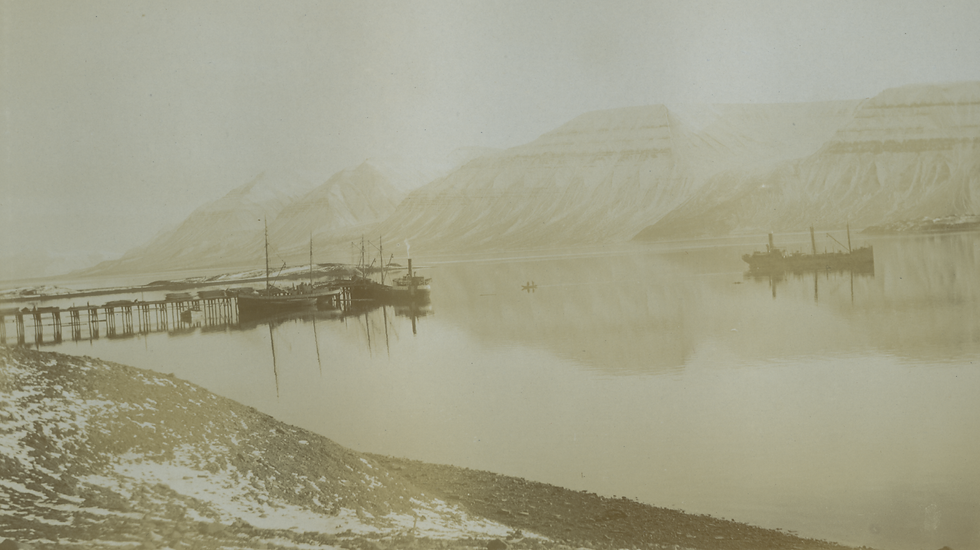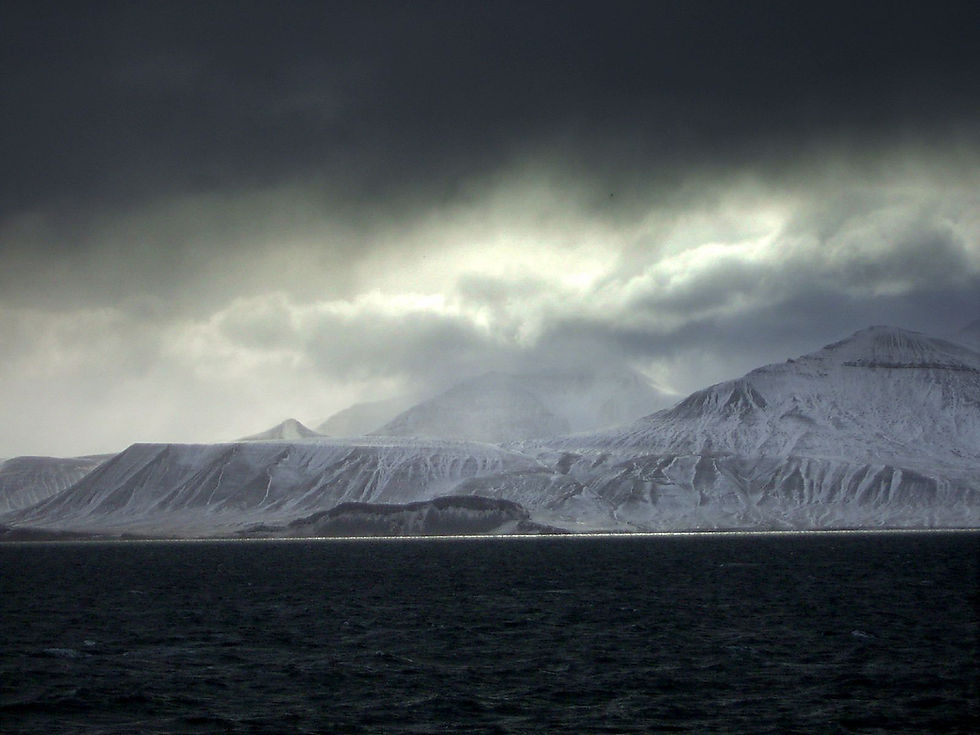Frozen Plans: A British Empire in the Arctic?
- EPOCH

- Dec 1, 2024
- 7 min read
Ben Markham | Maldon's Community Academy
The latter stages of the First World War and its immediate aftermath saw the focus of some policy-makers shift to the question of changing borders and territorial redistribution. Most famously, this consisted of fulfilling the Wilsonian principles of self-determination in Europe, reallocating the former territories of the German Empire in Africa and the Pacific, and carving up the Middle East. There are, however, other similar proposals from this period that are less well-known. One such example concerned potential British expansion into the Arctic by obtaining the archipelago of Spitsbergen (it is now known as Svalbard, and Spitsbergen is the largest island of this group).

For many years, Spitsbergen had been maintained by Norway, which itself had only separated from Sweden in 1905. By the outbreak of the First World War, throughout which Norway remained neutral, the question of establishing and formalising who held direct control over Spitsbergen had become a prominent one in Arctic affairs. In July 1917, a British MP, Charles Yate, addressed a memorandum to the British Cabinet outlining why he believed Britain should incorporate Spitsbergen into the empire. Yate considered the future of Spitsbergen to be a matter of ‘national importance’, especially as several British companies were operating on the islands and had developed an important coal industry there. He was particularly concerned about the role of rival German companies. He noted the presence of a German wireless station and cast doubt on Norwegian claims that it had been swiftly dismantled (although he failed to explain his reasons for these doubts). Yate remained convinced that Germany eventually aimed to take full control of Spitsbergen. In his mind, there was only one clear solution to the Spitsbergen question: the annexation of the islands by the British Empire. Frustrated by the lack of comment on the issue by both the Admiralty and the Foreign Office, Yate decided to address the War Cabinet directly instead.
Reports from both departments appeared only a few weeks later, with the Foreign Office producing theirs first. In contrast to Yate’s enthusiasm, these subsequent memoranda displayed far more reluctance regarding the matter. There was acknowledgement that British companies operating in Spitsbergen had called for formal annexation as recently as 1915, but this was viewed as diplomatically risky. So far as the Foreign Office was concerned, overall interest in the Arctic had dwindled significantly in recent years, and Spitsbergen, officially, had always been Terra Nullius (land not under the legal occupation of any state). Several nations – a mixture of neutral countries and Allied Powers – maintained a nominal claim over the territory, including Denmark, the Netherlands, Norway and Russia, as well as Britain. Even a recent conference on the issue, held a few weeks before the First World War began, had not changed this status. In this context, the Foreign Office concluded that any declaration of sovereignty over Spitsbergen at this late stage in the war risked either undermining Allied relations or pushing neutral states away from the Allied cause.
The Admiralty was even less convinced and rejected outright the proposal to incorporate Spitsbergen into the British Empire. For one thing, the islands were not located in a region considered to be strategically important and had no ice-free ports. Whilst there was an acknowledgement that Spitsbergen had at least some mineral wealth, these resources were by no means easily accessible. Moreover, a resident population would be almost entirely reliant on overseas supplies. The costs of a British-administered Spitsbergen far outweighed the benefits in the minds of those at the Admiralty. When members of the Cabinet met to discuss the matter in detail in late July 1917, the memoranda convinced them that no further action was required and Yate’s Arctic plan was frozen.

These views did not last, however. Less than a year later, in March 1918, Spitsbergen reappeared on the Cabinet agenda. Much had changed since its last appearance. The Russian Revolutions had seen Russian withdrawal from the conflict, its descent into a violent and bloody civil war, and the cession of a substantial portion of territory in Eastern Europe to Germany. In addition to this, the Allied powers were fighting on new fronts in an attempt to intervene in Russia, and German influence also appeared to be on the rise in newly-independent Finland.
As the only clear route to northern Russia, the Arctic had obtained a new significance. Spitsbergen now presented itself as a crucial source of coal and an important stopping point on the routes to the Kola Peninsula (where sizeable Allied resources still remained) and Siberia. If Germany obtained influence over Norway and, in turn, Spitsbergen, all of this would be jeopardised. Even once the war had ended, and the threat of Germany lessened, the potential for the Arctic islands had been revealed, and the question of who possessed them became a more important one.
The issue was returned to again once the war was finally over. Amidst other considerations regarding the shifting of borders and division of territory across Europe and beyond, a formal resolution regarding the future of Spitsbergen still needed to be decided. For British policy-makers, there were three possible options.
The first of these was annexation, as first raised by Yate in 1917. Although a popular option in British newspapers, policy-makers in London were far more reticent as British resources were already overstretched across the globe, and they were anyway yet to be convinced fully of Spitsbergen’s future value. The proposal that Canada obtain Greenland was anyway seen as the more attractive option as far as proposed new Arctic territories were concerned; although this, too, was ultimately not pursued over concerns regarding British imperial expansion so close in proximity to the United States.
The second option was internationalisation or condominium (joint rule involving multiple countries). This had been a suggested solution elsewhere with Sudan, the New Hebrides and Jerusalem all being prominent examples of being brought under some form of international administration – or at least discussed as potential candidates – during this period. This was viewed as potentially practical, but ultimately complicated due to the sheer volume of countries (both Allied and neutral) that maintained some form of claim to the archipelago. In addition to this, the Foreign Secretary, Lord Curzon, further warned that ‘we are faced with the prospect of incurring the resentment of the Norwegians’ if Britain supported such a proposal. Norway had, after all, remained neutral throughout, but (partially as a result of British pressure) had leant more towards supporting the Allies in terms of trade and foreign policy.

With this in mind, the third and final option was to recommend granting the islands to Norway. This was viewed as a much better solution for maintaining a positive Anglo-Norwegian relationship. Moreover, the Foreign Office noted, there were further benefits to a Norway-centric solution that would be felt far beyond the Arctic Ocean. The British Government had been pushing for Mandates elsewhere (notably in Africa, the Middle East and the Pacific) and some of these had been the source of intense discussions amongst the Allies. It was argued – or, at least, hoped – that supporting Norwegian annexation of Spitsbergen would limit international criticism that the British had ‘secured immense advantages and privileges themselves by being given mandates in other parts of the world.’
Norwegian control of Spitsbergen was seen as bringing further advantages as well: the ongoing Russian Civil War, along with technological developments made during the First World War, such as better flight and communications technology, had demonstrated that the Arctic would soon become a key geostrategic area of the world. By ensuring Norwegian control of Spitsbergen, British policy-makers reasoned that this pushed responsibility for Arctic defence and development of Arctic territory onto a friendly state without any real cost to Britain, whose finances had already been depleted severely by four years of global conflict.

After years of uncertainty – both before and after the war – as to the political future of Spitsbergen, a treaty was finally signed in 1920 between Norway, the USA, Denmark, France, Italy, Japan, the Netherlands, the British Empire and Sweden. It came into force five years later. Although the Treaty established Norwegian sovereignty over the entire archipelago, the signatories maintained a considerable number of rights over the territory. These included rights regarding hunting and fishing, mining and other commercial activities and access to ports. The Treaty also prohibited the creation of naval bases, fortifications and the use of the territory for warlike purposes, with the intention of limiting the threat of conflict in a region of emerging importance. With these concessions, British policy-makers got what they wanted: a foothold (of sorts) in the Arctic without the formal commitment or political and financial costs of outright annexation.
The Spitsbergen episode, although brief and largely unknown, remains a revealing one. Firstly, it represented an early example of post-war re-evaluation of strategic interests. The Arctic, now more so than ever before, was seen as an important area of influence. This new attention, however, was coupled with an increasing understanding that the British Empire could not simply expand to wherever it wanted. Concerns regarding the attitudes and goodwill of other Allies and neutral powers clearly needed to be considered more in this uncertain post-war world. The best way to achieve this, reasoned British policy-makers, was by freezing plans to extend northwards and instead confirm the Arctic islands as Norwegian.
Further Reading:
T. K. Derry, A History of Scandinavia: Norway, Sweden, Denmark, Finland, Iceland (University of Minnesota Press: Minneapolis and London, 1979).
Michael Jonas, Scandinavia and the Great Powers in the First World War (Bloomsbury Academic: London and New York, 2019).
Ben Markham, ‘The Northern Limit: Britain, Canada and Greenland, 1917-20’, The Historian, no. 138 (2018), pp. 35-39.
Richard Sale and Eugene Potapov, The Scramble for the Arctic: Ownership, Exploitation and Conflict in the Far North (Francis Lincoln: London, 2010).
Ben Markham was awarded his PhD in History by the University of Essex in 2017. He has written and delivered several papers on the theme of shifting international relations in the years immediately after the First World War. He teaches History at the Plume Academy in Maldon, Essex.
Twitter/X: @drben_historian






